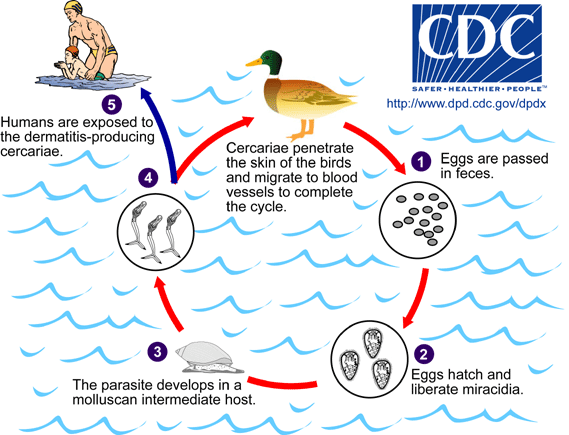Swimmer's itch is a condition often referred to as lake itch, duck itch, cercarial dermatitis and Schistosome cercarial dermatitis. It is caused by an immune response that is activated upon the entry of a water-borne flatworm parasite named schistosomatidae into the skin. The schistosomatidae results in an immune reaction in the skin that results in itchy, raised papules that occur within hours of infection.
There are numerous types of flatworm parasites within the family Schistosomatidae that can cause swimmer's itch. The schistosomatidae which are responsible for swimmer's itch include the genera Trichobilharzia and Gigantobilharzia. A species that is often implicated in cases of cercarial dermatitis is Austrobilharzia variglandis. The hosts of this species are ducks and the snail is the intermediate host for this species .

Life cycle of schistosomes
An overview of the life cycle of a schistosome and how they can cause swimmer's itch in humans.
The life cycle of these parasites is characterized by their use of both freshwater snails and vertebrates as hosts. More specifically, waterfowl are used as the vertebrate host. During the life stage of these parasites, the larvae of the parasite, cercaria, exit the water snails and can accidentally come into contact with the skin of a swimmer. Upon contact with the skin of the swimmer, the cercaria will penetrate the skin and immediately die in the skin. Interestingly, the cercaria are unable to survive within a human host and cause infection. The symptoms and reactions exhibited in individuals diagnosed with swimmer's itch are a result of the dead cercaria larvae.
If indeed the cercaria encounter a water bird, their normal host, the cercaria will penetrate the skin of the birds and migrate to the blood vessels to complete the cycle. For completion of the cycle, adult worms will form in the blood vessels and produce eggs which are passed in the feces. The eggs, upon exposure to water, will hatch into a miracidium that is ciliated. This form in the life cycle infects the snail intermediate host. In turn, the cercaria which are responsible for swimmer's itch are produced.